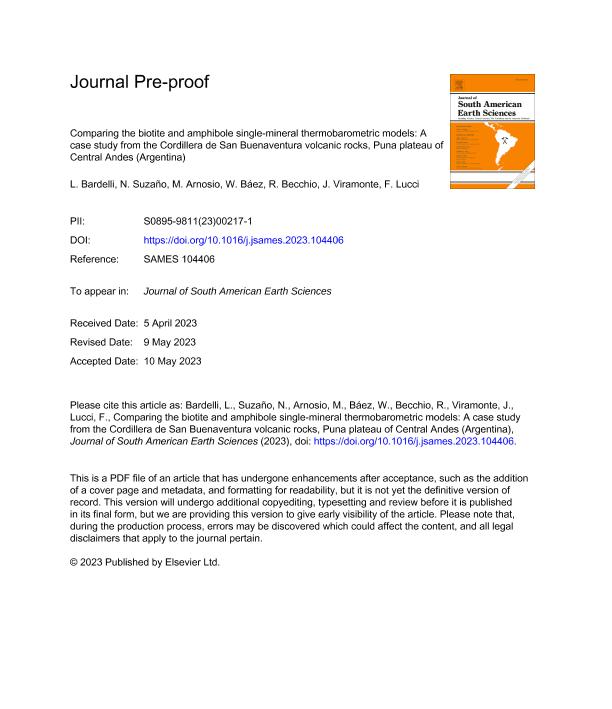Mostrar el registro sencillo del ítem
dc.contributor.author
Bardelli, Lorenzo

dc.contributor.author
Suzaño, Nestor Omar

dc.contributor.author
Arnosio, M.
dc.contributor.author
Baez, Walter Ariel

dc.contributor.author
Becchio, Raul Alberto

dc.contributor.author
Viramonte, Jose German

dc.contributor.author
Lucci, F.
dc.date.available
2024-03-13T11:33:32Z
dc.date.issued
2023-07
dc.identifier.citation
Bardelli, Lorenzo; Suzaño, Nestor Omar; Arnosio, M.; Baez, Walter Ariel; Becchio, Raul Alberto; et al.; Comparing the biotite and amphibole single-mineral thermobarometric models: A case study from the Cordillera de San Buenaventura volcanic rocks, Puna plateau of Central Andes (Argentina); Pergamon-Elsevier Science Ltd; Journal of South American Earth Sciences; 127; 7-2023; 1-29
dc.identifier.issn
0895-9811
dc.identifier.uri
http://hdl.handle.net/11336/230302
dc.description.abstract
We applied a new thermobarometric model based solely on biotite composition to the trachyandesitic to rhyolitic volcanic rocks of the Cordillera de San Buenaventura, a long-lived magma plumbing system (spanning from the Late Miocene to the Holocene) in the Southern Puna plateau (Central Volcanic Zone of the Andean Cordillera). Within these rocks, biotite is a widespread mineral phase found in association with amphibole, as either glomerocrysts, mutual inclusions, or free phenocrysts. This allowed us to compare the biotite-only model with other thermobarometric estimates that rely on amphibole, mineral-melt, and mineral-mineral composition. Our goal was to determine the conditions of formation for biotite and its petrogenetic significance in the evolution of the Cordillera de San Buenaventura magma system. The results indicate that biotite crystallization occurred mainly at middle-to upper-crustal depths (2.1–5.1 kbar) with temperatures below 1000 °C (763–919 °C). The biotite-only T-P estimates for individual lithologies are consistent with those obtained using the amphibole-only model, and this is particularly true for the thermometer. Furthermore, our findings align with the existing petrogenetic models, which suggest extensive fractional crystallization, and with the analyses of mineral textures, that indicates events of magma replenishment. Therefore, our results support the validity of the biotite-only model and its ability to elucidate magmatic processes, including magma differentiation via fractional crystallization, magma ascent and cooling, and magma replenishment and/or mixing events.
dc.format
application/pdf
dc.language.iso
eng
dc.publisher
Pergamon-Elsevier Science Ltd

dc.rights
info:eu-repo/semantics/openAccess
dc.rights.uri
https://creativecommons.org/licenses/by-nc-sa/2.5/ar/
dc.subject
AMPHIBOLE-ONLY THERMOBAROMETER
dc.subject
BIOTITE-ONLY THERMOBAROMETER
dc.subject
MAGMA PLUMBING SYSTEM
dc.subject
PUNA PLATEAU
dc.subject.classification
Vulcanología

dc.subject.classification
Ciencias de la Tierra y relacionadas con el Medio Ambiente

dc.subject.classification
CIENCIAS NATURALES Y EXACTAS

dc.title
Comparing the biotite and amphibole single-mineral thermobarometric models: A case study from the Cordillera de San Buenaventura volcanic rocks, Puna plateau of Central Andes (Argentina)
dc.type
info:eu-repo/semantics/article
dc.type
info:ar-repo/semantics/artículo
dc.type
info:eu-repo/semantics/publishedVersion
dc.date.updated
2024-03-12T11:07:56Z
dc.journal.volume
127
dc.journal.pagination
1-29
dc.journal.pais
Estados Unidos

dc.description.fil
Fil: Bardelli, Lorenzo. Consejo Nacional de Investigaciones Científicas y Técnicas. Centro Científico Tecnológico Conicet - Salta. Instituto de Bio y Geociencias del NOA. Universidad Nacional de Salta. Facultad de Ciencias Naturales. Museo de Ciencias Naturales. Instituto de Bio y Geociencias del NOA; Argentina
dc.description.fil
Fil: Suzaño, Nestor Omar. Consejo Nacional de Investigaciones Científicas y Técnicas. Centro Científico Tecnológico Conicet - Salta. Instituto de Bio y Geociencias del NOA. Universidad Nacional de Salta. Facultad de Ciencias Naturales. Museo de Ciencias Naturales. Instituto de Bio y Geociencias del NOA; Argentina
dc.description.fil
Fil: Arnosio, M.. Consejo Nacional de Investigaciones Científicas y Técnicas. Centro Científico Tecnológico Conicet - Salta. Instituto de Bio y Geociencias del NOA. Universidad Nacional de Salta. Facultad de Ciencias Naturales. Museo de Ciencias Naturales. Instituto de Bio y Geociencias del NOA; Argentina
dc.description.fil
Fil: Baez, Walter Ariel. Consejo Nacional de Investigaciones Científicas y Técnicas. Centro Científico Tecnológico Conicet - Salta. Instituto de Bio y Geociencias del NOA. Universidad Nacional de Salta. Facultad de Ciencias Naturales. Museo de Ciencias Naturales. Instituto de Bio y Geociencias del NOA; Argentina
dc.description.fil
Fil: Becchio, Raul Alberto. Consejo Nacional de Investigaciones Científicas y Técnicas. Centro Científico Tecnológico Conicet - Salta. Instituto de Bio y Geociencias del NOA. Universidad Nacional de Salta. Facultad de Ciencias Naturales. Museo de Ciencias Naturales. Instituto de Bio y Geociencias del NOA; Argentina
dc.description.fil
Fil: Viramonte, Jose German. Consejo Nacional de Investigaciones Científicas y Técnicas. Centro Científico Tecnológico Conicet - Salta. Instituto de Bio y Geociencias del NOA. Universidad Nacional de Salta. Facultad de Ciencias Naturales. Museo de Ciencias Naturales. Instituto de Bio y Geociencias del NOA; Argentina
dc.description.fil
Fil: Lucci, F.. Università degli Studi di Bari; Italia
dc.journal.title
Journal of South American Earth Sciences

dc.relation.alternativeid
info:eu-repo/semantics/altIdentifier/url/https://www.sciencedirect.com/science/article/pii/S0895981123002171
dc.relation.alternativeid
info:eu-repo/semantics/altIdentifier/doi/http://dx.doi.org/10.1016/j.jsames.2023.104406
Archivos asociados
